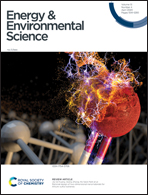Gas phase synthesis of amorphous silicon nitride nanoparticles for high-energy LIBs†
Abstract
Various morphological nanoscale designs have come into the spotlight to address the failure in the mechanism of high-capacity Si anodes, i.e. severe volume expansion (∼300%). However, the nanostructured Si anodes designed still suffer mechanical degradation upon repeated cycling, and eventually become shredded and surrounded by accumulated solid electrolyte interphase (SEI) layers. Here, we introduce a highly homogenous phase design of Si with N by scalable gas phase synthesis, which tackles the intrinsic challenges of Si anodes, i.e. mechanical degradation and slow Li diffusion. Si-rich silicon nitride (SiN) nanoparticles are realized using a specially customized vertical furnace, where Si3N4 acts as not only a strong inactive matrix but also a Li ion conductor after lithiation. Owing to their stubborn and ionic conductive matrix, SiN nanoparticles exhibit superior rate performances and cycling stability while maintaining their dense structure. Accordingly, when combined with commercially viable graphite-blended system for the pouch-type 1 A h cell, SiN nanoparticles demonstrate high rate capability at 5C, as well as contributing much higher capacity than silicon nanoparticles by mitigating electrode swelling during cycling.



 Please wait while we load your content...
Please wait while we load your content...